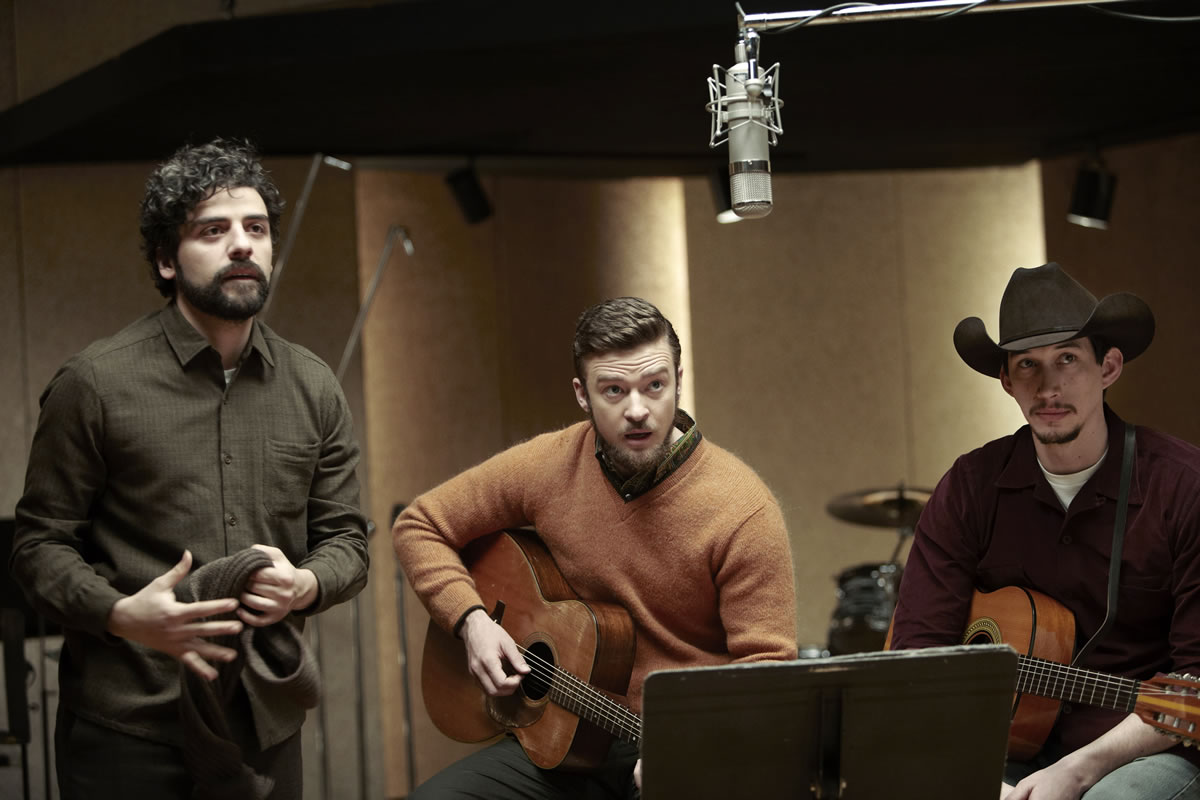One of the most beguiling folk records of the year has the bonus of ferrying along a Joel and Ethan Coen plotline. The songs within the brothers’ new “Inside Llewyn Davis” move from balladry to blues to ancient British folk, adding an extra layer of lyricism and revealing a portal to another storytelling realm.
The selections and performances highlight a moment when a perfectly realized stanza sung honestly in a smoky cafe could produce an audible gasp, reverberate throughout New York’s Greenwich Village and, with luck or if your name was Bob Dylan, American culture.
At the center of the story, set in 1961, is the singer Llewyn Davis, an expert but oft-unlikable artist, and a few pivotal performances, most significantly of “Hang Me, Oh Hang Me,” brought to prominence by singer Dave Van Ronk. Van Ronk’s memoir “The Mayor of MacDougal Street” and “Inside Dave Van Ronk” album cover supplied many of the period details for the Coens’ fictional story. “Hang Me,” the most recent of a series of songs that the Coens have plucked from relative obscurity to create fresh filmic moments, is sung from the perspective of a rebel who “went up to the mountain, that’s where I made my stand” and, having apparently failed, is bound for the noose.
Even more than the Coens’ ode to rural country music, “O Brother Where Art Thou,” whose protagonists fall into the music business by happenstance, “Inside Llewyn Davis” examines an occupation, singing and songwriting, with wry affection.
Joel Coen told me during a recent conversation that the new movie, on which they collaborated with music producer T Bone Burnett, is the product of “a funny conversation that we’ve been having with T Bone for decades, from project to project, starting with ‘The Big Lebowski.’ “
As such, it’s a revelatory, loving and sometimes absurd look at the life of the musician, with a curated playlist starring actor-singers Oscar Isaac, Justin Timberlake, Carey Mulligan and others. Moving in unison with the action during sets and sessions, the music scores our antihero’s circular journey from Greenwich Village to Chicago and back again.
The Coens’ precise touch is captured, for example, in a notable absence: a spectral Bob Dylan, then a freshman on the scene whose arrival and impending fame are only suggested. At the beginning, we briefly hear him tuning his guitar onstage, but the Coens are following another touched singer, so the action moves elsewhere. That single shot teases a big American story developing just outside the frame: the tune-up to a whole movement that Dylan would help construct.
Such deftness isn’t surprising. The Coens’ best musical placements over the years are so memorable that they deserve their own super-cut: There’s the rollicking, yodeled theme that chases Nicolas Cage’s H.I. McDunnough through “Raising Arizona.” To the kidnapped Nathan Jr., Holly Hunter’s character Edwina sings a tender lullaby, which is in fact a murder ballad called “Down in the Willow Garden,” signaling doom on the horizon. Lower East Side folk punks the Fugs’ biting protest song “CIA Man” closes “Burn After Reading”; the scratchy “Danny Boy” recording that bellows from a Victrola in “Miller’s Crossing” scores an Albert Finney machine-gun shootout.
Memorably, “The Big Lebowski” resurrected an obscure psychedelic rock song, “Just Dropped In (To See What Condition My Condition Was In),” turning it into a stoner anthem after it scored the Dude’s bowling-themed dream sequence. “O Brother,” another Burnett-produced effort, featured the fictional Soggy Bottom Boys’ rendition of “Man of Constant Sorrow.” It played a key role in that soundtrack going platinum — more than half a century after the song’s would-be heyday.
“The conversation expands in really interesting ways once we get T Bone involved in it,” Joel Coen said. “He gets into the story, or the script, or whatever project we’re working on, and takes it in places musically that we wouldn’t have thought of, or didn’t know about, and opens up all of these interesting things.”
In “Llewyn Davis,” music levitates the story. As Davis, played by Isaac, travels from Upper West Side to the Village with an escaped cat that will come to haunt him, the song “Fare Thee Well (Dink’s Song)” plays, suggesting a few different journeys to come. While a sofa-crashing Southern singer offers a gentle version of Tom Paxton’s “The Last Thing on My Mind” and croons of “a lesson too late for learnin’,” a character played by Mulligan informs Davis that she’s pregnant.
Joel Coen said the placements came naturally and were part of the fabric of the script early on. The desire was to suggest, without being clumsy or heavyhanded.
“You’re thinking about both what the song is lyrically,” he said, “but what’s the vibe of the song? What’s the mood of it, even the tempo? What does it need here? We didn’t want things to be right on the nose, but sometimes they were lyrically related in interesting ways to what was happening.”
Granted, this isn’t Ken Russell using the Who’s rock opera “Tommy” as a storyboard. Lines aren’t played out within the narrative. Rather, Ethan Coen described the process as “mushy,” adding that “you feel out what’s right for the character and the place in the story.”
The choice, for example, to have Davis sing the haunting British ballad “The Death of Queen Jane” during an audition with a hotshot manager is revealing. “He goes to his big audition and he sings a song about an abortion,” Burnett said, laughing. “There’s so much stuff hidden in here. Every one of these songs, ‘Hang Me, Oh Hang Me,’ ‘Fare Thee Well,’ there’s a distinct story being told in the libretto, really.”
“The exercise there,” Ethan Coen said, “is, what’s the most beautiful song he could sing at this point that would also be the most self-destructive?”



